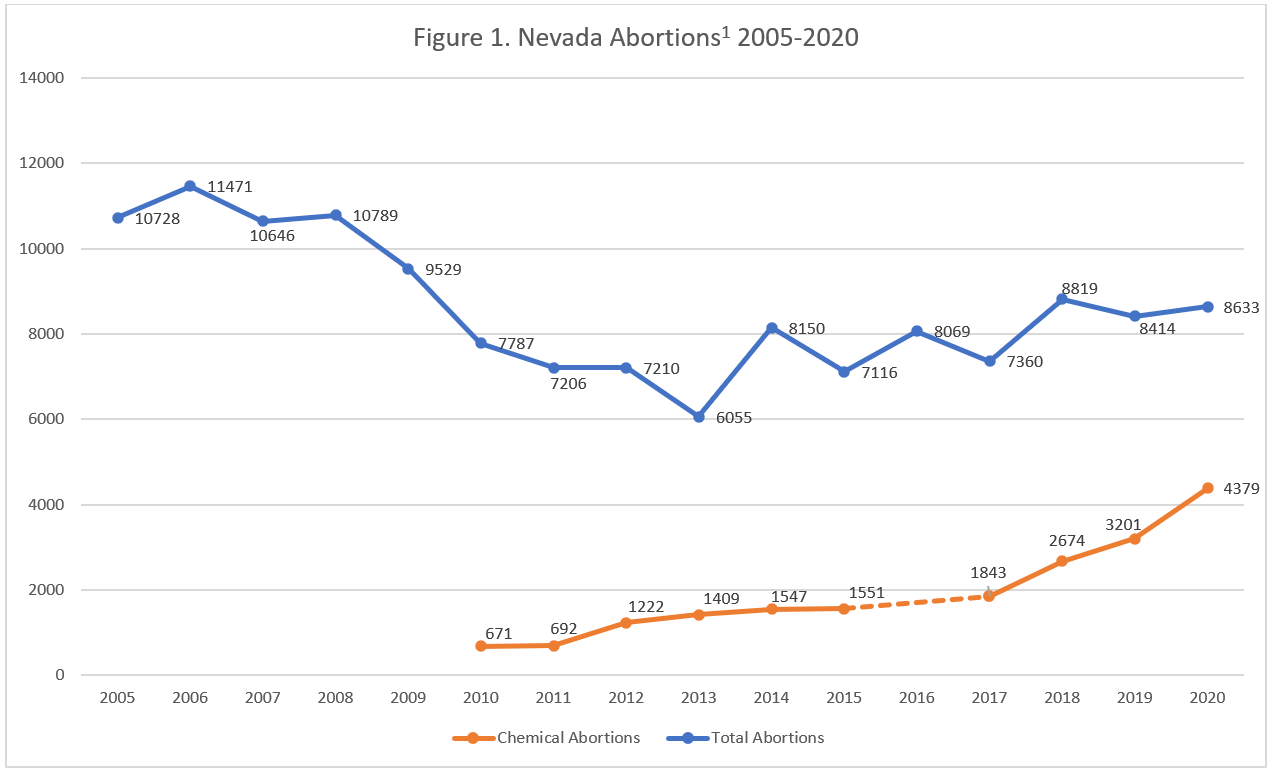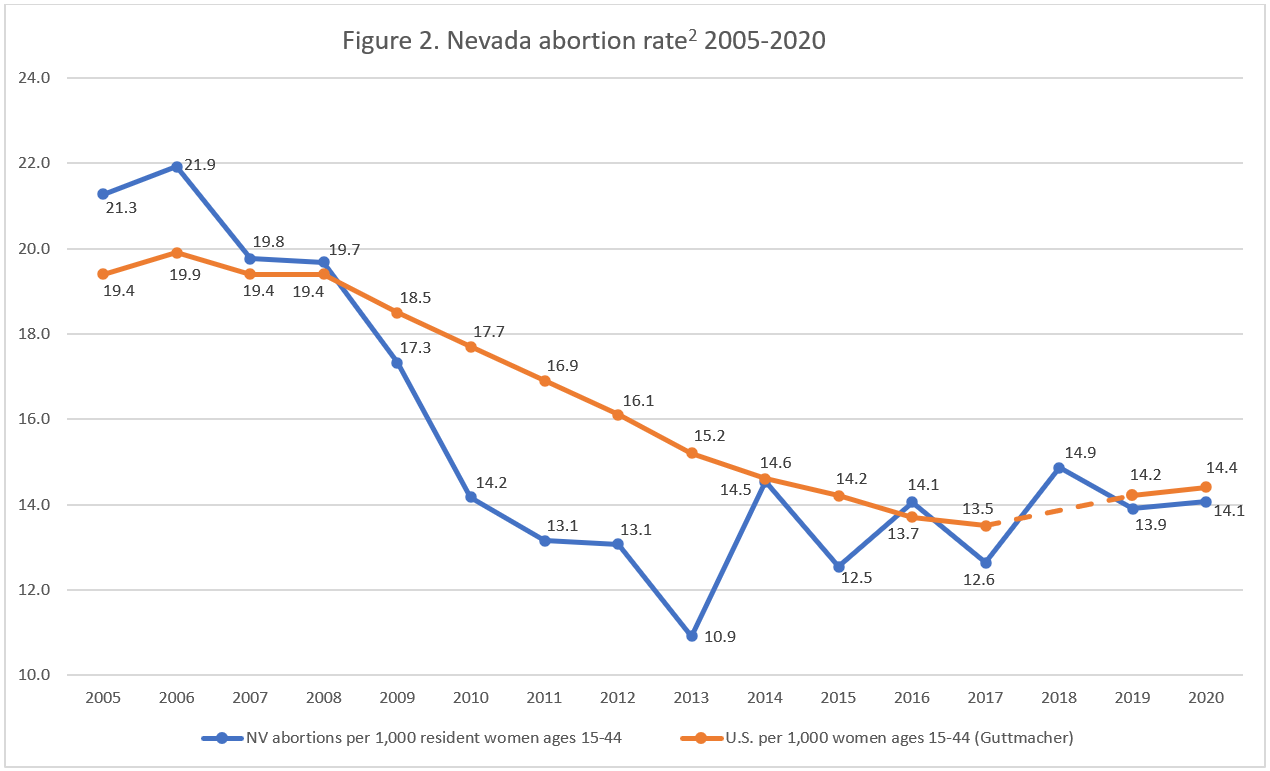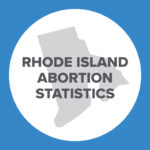Abortion Reporting: Nevada (2020)
Nevada’s 2020 abortion statistics were provided to the Charlotte Lozier Institute (CLI) by the Nevada Department of Health and Human Services upon request. The report shows that total abortions as well as the total number of chemical abortions that occurred in the state increased from 2019.
Statistics and Changes in Nevada Abortions, 2019-2020

Abortion Totals and Trends
In 2020, there were 8,633 abortions reported in Nevada, an increase of three percent from the previous year (Fig. 1). There were 8,162 abortions performed in Nevada on state residents, up three percent from 2019. Just over half (51 percent) of the abortions performed in Nevada (4,379 abortions) were chemical, with the total number of chemical abortions occurring in the state increasing by 37 percent from the previous year. CLI estimates that Nevada’s 2020 abortion rate was 14.1 abortions per 1,000 women of childbearing age, almost mirroring the national average for 2020 of 14.4 and an increase of one percent from Nevada’s 2019 rate of 13.9 (Fig. 2).
State Report Summary
Ninety-five percent of the abortions reported in Nevada in 2019 were performed on state residents. Five percent or 471 abortions reported in Nevada were performed on nonresidents. In previous years, the Nevada Department of Health and Human Services provided CLI with data covering only abortions performed on Nevada residents. However, the 2020 data given to CLI covers all abortions that occurred in Nevada, whether they were performed on Nevada resident women or nonresidents.
A majority of the abortions (53 percent) were obtained by women in their twenties, with 26 percent on women ages 20 to 24 and 27 percent on women ages 25 to 29. Thirty-one percent were performed on women in their thirties, and four percent were on women in their forties, while nine percent of the abortions were performed on girls ages 19 and younger, including three percent on girls under the age of 18. The youngest girl to get an abortion was 11, and the oldest woman was 48. Three percent of Nevada abortions were performed on women of an unknown age.
Five percent of Nevada abortions were on women with less than a high school education, and 37 percent were on women with a high school diploma or GED. Seventeen percent were performed on women who had attended some college but did not obtain a degree. Eleven percent of Nevada abortions were on women with a college degree, and 30 percent were on women whose level of education was not reported.
Five percent of the abortions were reported to have been performed on married women, and 35 percent were performed on unmarried women. Sixty percent of the abortions that occurred in Nevada were performed on women whose marital status was not reported. Forty-three percent of the abortions were performed on women with no children, while 21 percent were on women with one child and 36 percent on women with two or more children.
In 2020, 42 percent of the abortions performed in Nebraska were suction curettage procedures. Just over half (51 percent) were chemical, and five percent were conducted via dilation and evacuation. There were 246 hysterotomy/hysterectomy abortions, three sharp curettage abortions, and one intrauterine instillation abortion.
Thirteen abortions (0.2 percent) were reported at zero weeks of gestation, although typically conception does not occur until the second week of gestation (two weeks after the start of the woman’s last menstrual period). Seventy abortions (0.8 percent) were reported between one and four weeks. Thirty-nine percent occurred between five and six weeks of gestation, and 30 percent were performed between seven and eight weeks. Fifteen percent were performed between nine and 10 weeks of gestation, while six percent occurred between 11 and 12 weeks and five percent were reported from 13 to 15 weeks of gestation. Three percent of the abortions were performed between 16 and 19 weeks, and two percent occurred at 20 weeks of gestation and later. The latest reported abortion was performed at 25 weeks of gestation, well past the time when babies can feel pain. Gestational age was not reported for 0.7 percent of the abortions.
Abortion Centers in Nevada
Fourteen percent of Nevada abortions were performed by Planned Parenthood (nine percent by Planned Parenthood’s West Charleston center and five percent by the East Flamingo location). Eighty-six percent of the abortions were performed by independent abortion centers. Thirty-two percent of the abortions were performed by Birth Control Care Center, and 28 percent were reported by A-Z Women’s Center. West End Women’s Medical Group performed 12 percent, and nine percent occurred at Women to Women Gynecology. Desert Inn Medical Center reported four percent of the abortions. Planned Parenthood’s Nevada abortion centers perform only chemical abortions, so it is likely that all the surgical abortions occurred at independent abortion centers.
Legislative Changes
Following the Supreme Court’s decision to overturn Roe v. Wade (1973), the former governor of Nevada, Steve Sisolak (D), signed an executive order in August 2022 titled “Protecting Access to Reproductive Health Services in Nevada.” This executive order reaffirmed Nevada’s commitment to “long protected reproductive freedom” and reviewed actions that voters and/or the legislature have taken to protect abortion since abortion became legal in Nevada. As the law stands, abortion is legal in Nevada until 24 weeks’ gestation and past 24 weeks’ gestation “if the physician has reasonable cause to believe that abortion currently is necessary to preserve the life or health of the pregnant woman.”
State Ranking
In 2016, a CLI study evaluated abortion reporting across the 50 states and ranked Nevada’s reporting at 38th best. Since then, Nevada has improved its reporting by making reports available on a regular schedule. To further improve its reporting and increase transparency, Nevada could publish its reports online, as most other states do. Nevada could also collect and report data on complications caused by abortion and take steps to ensure that all abortions are reported.


- Abortion occurrence totals were obtained from the Nevada Department of Health and Human Services upon request. Chemical abortion totals were obtained from CDC. 2010 was the first year of chemical abortion data that Nevada reported to CDC. Because the 2016 abortion total Nevada shared with CLI was far higher than that reported to CDC, CDC’s 2016 Nevada chemical abortion total is not included in this graph.
- Rates were calculated by CLI using the following formula: (total number of abortions performed in Nevada ÷ number of resident women ages 15-44) x 1,000. Rates may differ slightly from previous CLI articles due to revised population estimates and abortion totals. Population estimates were obtained from the CDC WONDER database. Estimates for 2005-2009 are intercensal estimates of the July 1 resident population. Estimates for 2010-2020 are Vintage 2020 postcensal estimates of the July 1 resident population. Estimates were produced by the U.S. Census Bureau and the National Center for Health Statistics.
























